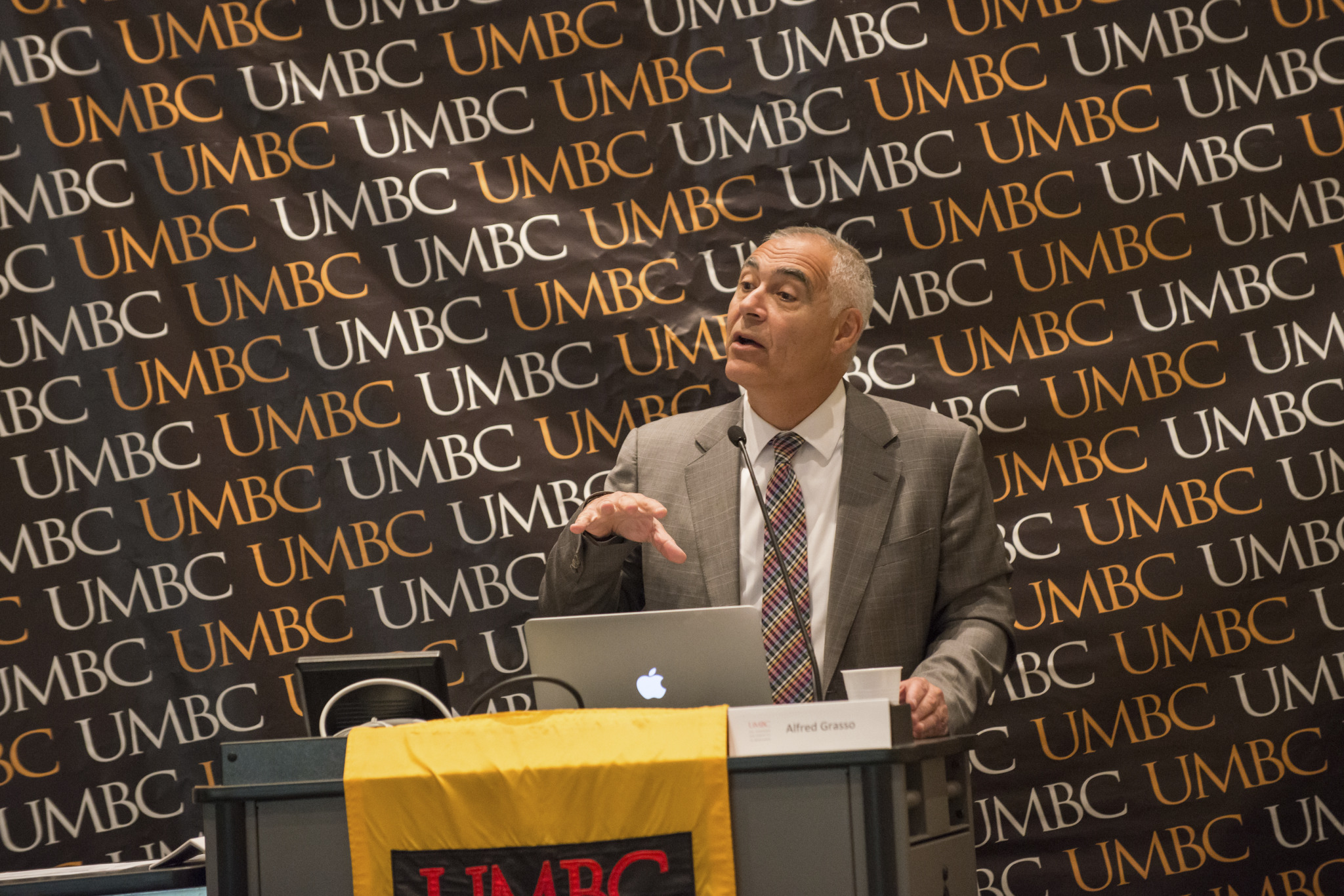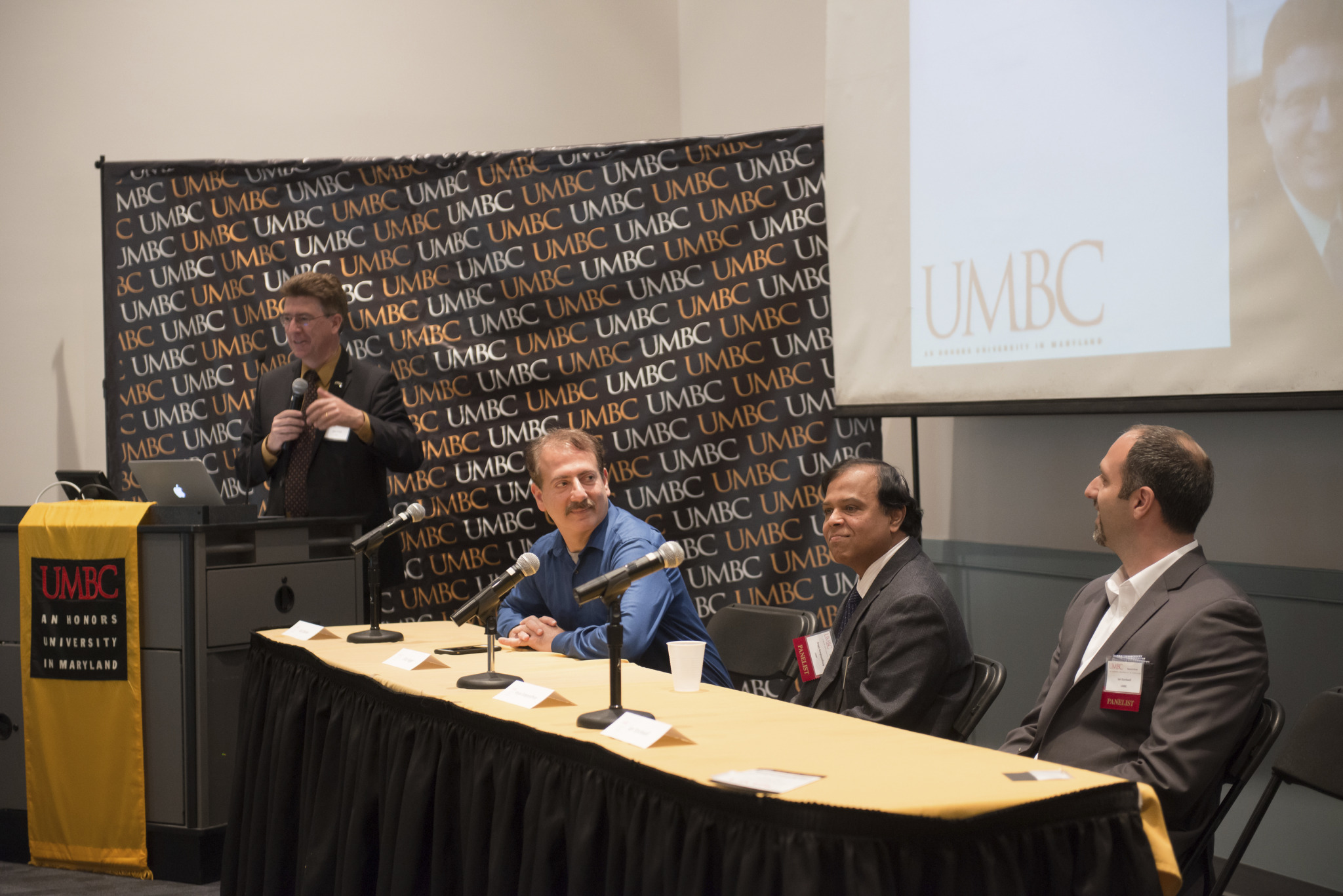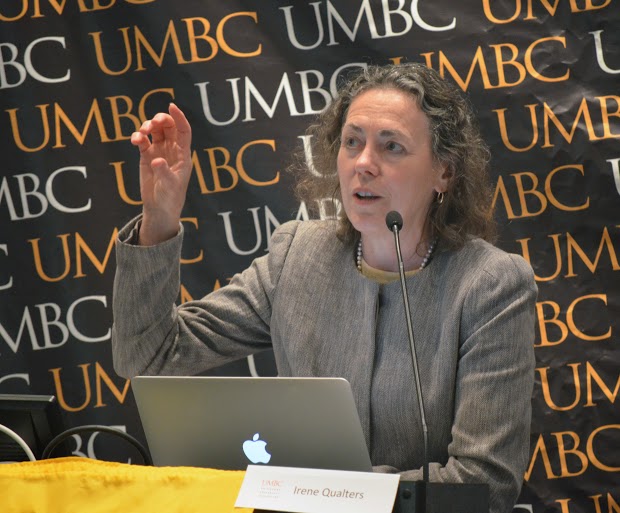By Sarah Hansen
Thumbnail: Forum attendees mingle during a poster session.
UMBC hosted its semi-annual Research Forum on May 1, 2015. This semester’s forum focused on the role high-performance computing (HPC) can play in a variety of interdisciplinary applications, and featured speakers from diverse programs such as information systems, chemistry and biochemistry, geography and environmental systems, and computer science and electrical engineering. UMBC President Freeman Hrabowski noted, “The mid-Atlantic region has one of the greatest concentrations of super-computing in the world. That gives us a certain advantage as researchers.” One key advantage is the facility of creating partnerships, “not just between universities, but with companies,” Hrabowski said.
The forum keynote speaker, Al Grasso, is the CEO of MITRE Corporation, a critical UMBC partner. MITRE and the University System of Maryland are developing the first federally-funded research and development center (FFRDC) devoted exclusively to cybersecurity. It’s also unique among the FFRDCs, because it addresses applications in both the public and private sectors.
“I couldn’t think of a better partner to have to deal with one of the most complex problems that this nation and, quite frankly, the world face today,” said Grasso of UMBC. The group of institutions involved in the FFRDC is “the brain trust in this country” for cybersecurity, Grasso added. While the current partnership is focused on the FFRDC and cybersecurity, Grasso hopes MITRE’s partnership with UMBC will expand. “What excites me is not only what we’re doing today, but what we could be doing in the future,” he said.

Keynote speaker and MITRE CEO Al Grasso addresses forum attendees.
Jack Suess, UMBC Vice President of Information Technology, said, “HPC is the poster child for these kinds of collaborations here at UMBC.” Several industry partners and 16 departments at UMBC have all contributed funds to grow the university’s computing power for research, which creates a “robust HPC environment,” he said. Matthias Gobbert, Director of the High-performance Computing Facility at UMBC, added that in April 2015 there were 71 active users of the facility from 28 different research groups on campus. Seventeen theses and 181 other publications have come from work done at the facility since 2008.
UMBC’s growing computing power is impressive, but research on these machines addresses fundamental questions that are “nothing new,” according to Milt Halem, UMBC Site Director of the Center for Hybrid Multicore Productivity. Compared to several decades ago, “what’s different is the scale and scope of these problems,” he said.
A panel at the forum addressed how HPC can impact health care. “High-performance computing has the potential to completely change the way we practice medicine,” said Eliot Siegel, Professor of Diagnostic Radiology at the University of Maryland School of Medicine. He envisions doctors using gigantic databases to help recommend treatments and make prognoses based on thousands of data points from patients with similar backgrounds and symptoms. With fingertip access to thorough aggregate health information and advanced computational tools, doctors could answer some patient questions, like “How likely is my cancer to go into remission with surgery alone?” in seconds rather than days.

UMBC VP for Research Karl Steiner (far left) introduces the health IT panel: Eliot Siegel (left), Aryya Gangopadhyay (center) and Ian Stockwell (right).
Ian Stockwell, Director of Special Studies at UMBC’s Hilltop Institute, sees another use for HPC in health care. “Health and medicine are not the same thing,” he said. Getting to a doctor’s office or pharmacy is a challenge for many, and housing quality and location can play a big role in physical and emotional health, too. Stockwell is working on using HPC to integrate information about an individual’s lifestyle and medical history, which would allow for a more holistic approach to health. That would create the possibility of providing non-medical (and often less-expensive) interventions that improve health. Stockwell acknowledges the challenges to an integrative approach, such as initially getting individuals to fill out extensive surveys about their lifestyle, but “anything we can do is better than the status quo,” he said.
The two afternoon panels focused on cybersecurity and on modeling, simulation and visualization. Poster sessions allowed for mingling, in hopes that attendees would forge new collaborations. Irene Qualters, Director of Advanced Cyberinfrastructure at the National Science Foundation, also spoke. She emphasized the diversity of computational requirements and instrumentation for new research projects. She also addressed the unprecedented growth in data collection that HPC makes possible and the importance of collaboration. “Collaborations are geographically distributed and conversations are international,” she said. And, with research budgets expected to stay flat, “that will be more incentive to collaborate across agencies,” she added.

Forum speaker Irene Qualters makes a point.
While challenges like funding can make research today tricky, Qualters is quick to point out the silver lining. “This is a world of opportunity. This is an important and a very exciting time, and I hope you’re feeling it at your institution,” she said. The Research Forum and new FFRDC demonstrate that UMBC is pouncing on new opportunities. President Hrabowski acknowledged that in this era of tight funding, “the name of the game will be interdisciplinarity, collaboration, having the right attitude, multi-year process, and execution,” he said. “Welcome to UMBC.”
Thumbnail: Forum attendees mingle during a poster session.
UMBC hosted its semi-annual Research Forum on May 1, 2015. This semester’s forum focused on the role high-performance computing (HPC) can play in a variety of interdisciplinary applications, and featured speakers from diverse programs such as information systems, chemistry and biochemistry, geography and environmental systems, and computer science and electrical engineering. UMBC President Freeman Hrabowski noted, “The mid-Atlantic region has one of the greatest concentrations of super-computing in the world. That gives us a certain advantage as researchers.” One key advantage is the facility of creating partnerships, “not just between universities, but with companies,” Hrabowski said.
The forum keynote speaker, Al Grasso, is the CEO of MITRE Corporation, a critical UMBC partner. MITRE and the University System of Maryland are developing the first federally-funded research and development center (FFRDC) devoted exclusively to cybersecurity. It’s also unique among the FFRDCs, because it addresses applications in both the public and private sectors.
“I couldn’t think of a better partner to have to deal with one of the most complex problems that this nation and, quite frankly, the world face today,” said Grasso of UMBC. The group of institutions involved in the FFRDC is “the brain trust in this country” for cybersecurity, Grasso added. While the current partnership is focused on the FFRDC and cybersecurity, Grasso hopes MITRE’s partnership with UMBC will expand. “What excites me is not only what we’re doing today, but what we could be doing in the future,” he said.
Keynote speaker and MITRE CEO Al Grasso addresses forum attendees.
Jack Suess, UMBC Vice President of Information Technology, said, “HPC is the poster child for these kinds of collaborations here at UMBC.” Several industry partners and 16 departments at UMBC have all contributed funds to grow the university’s computing power for research, which creates a “robust HPC environment,” he said. Matthias Gobbert, Director of the High-performance Computing Facility at UMBC, added that in April 2015 there were 71 active users of the facility from 28 different research groups on campus. Seventeen theses and 181 other publications have come from work done at the facility since 2008.
UMBC’s growing computing power is impressive, but research on these machines addresses fundamental questions that are “nothing new,” according to Milt Halem, UMBC Site Director of the Center for Hybrid Multicore Productivity. Compared to several decades ago, “what’s different is the scale and scope of these problems,” he said.
A panel at the forum addressed how HPC can impact health care. “High-performance computing has the potential to completely change the way we practice medicine,” said Eliot Siegel, Professor of Diagnostic Radiology at the University of Maryland School of Medicine. He envisions doctors using gigantic databases to help recommend treatments and make prognoses based on thousands of data points from patients with similar backgrounds and symptoms. With fingertip access to thorough aggregate health information and advanced computational tools, doctors could answer some patient questions, like “How likely is my cancer to go into remission with surgery alone?” in seconds rather than days.
UMBC VP for Research Karl Steiner (far left) introduces the health IT panel: Eliot Siegel (left), Aryya Gangopadhyay (center) and Ian Stockwell (right).
Ian Stockwell, Director of Special Studies at UMBC’s Hilltop Institute, sees another use for HPC in health care. “Health and medicine are not the same thing,” he said. Getting to a doctor’s office or pharmacy is a challenge for many, and housing quality and location can play a big role in physical and emotional health, too. Stockwell is working on using HPC to integrate information about an individual’s lifestyle and medical history, which would allow for a more holistic approach to health. That would create the possibility of providing non-medical (and often less-expensive) interventions that improve health. Stockwell acknowledges the challenges to an integrative approach, such as initially getting individuals to fill out extensive surveys about their lifestyle, but “anything we can do is better than the status quo,” he said.
The two afternoon panels focused on cybersecurity and on modeling, simulation and visualization. Poster sessions allowed for mingling, in hopes that attendees would forge new collaborations. Irene Qualters, Director of Advanced Cyberinfrastructure at the National Science Foundation, also spoke. She emphasized the diversity of computational requirements and instrumentation for new research projects. She also addressed the unprecedented growth in data collection that HPC makes possible and the importance of collaboration. “Collaborations are geographically distributed and conversations are international,” she said. And, with research budgets expected to stay flat, “that will be more incentive to collaborate across agencies,” she added.
Forum speaker Irene Qualters makes a point.
While challenges like funding can make research today tricky, Qualters is quick to point out the silver lining. “This is a world of opportunity. This is an important and a very exciting time, and I hope you’re feeling it at your institution,” she said. The Research Forum and new FFRDC demonstrate that UMBC is pouncing on new opportunities. President Hrabowski acknowledged that in this era of tight funding, “the name of the game will be interdisciplinarity, collaboration, having the right attitude, multi-year process, and execution,” he said. “Welcome to UMBC.”
Tags:
Posted: May 15, 2015, 5:59 PM
